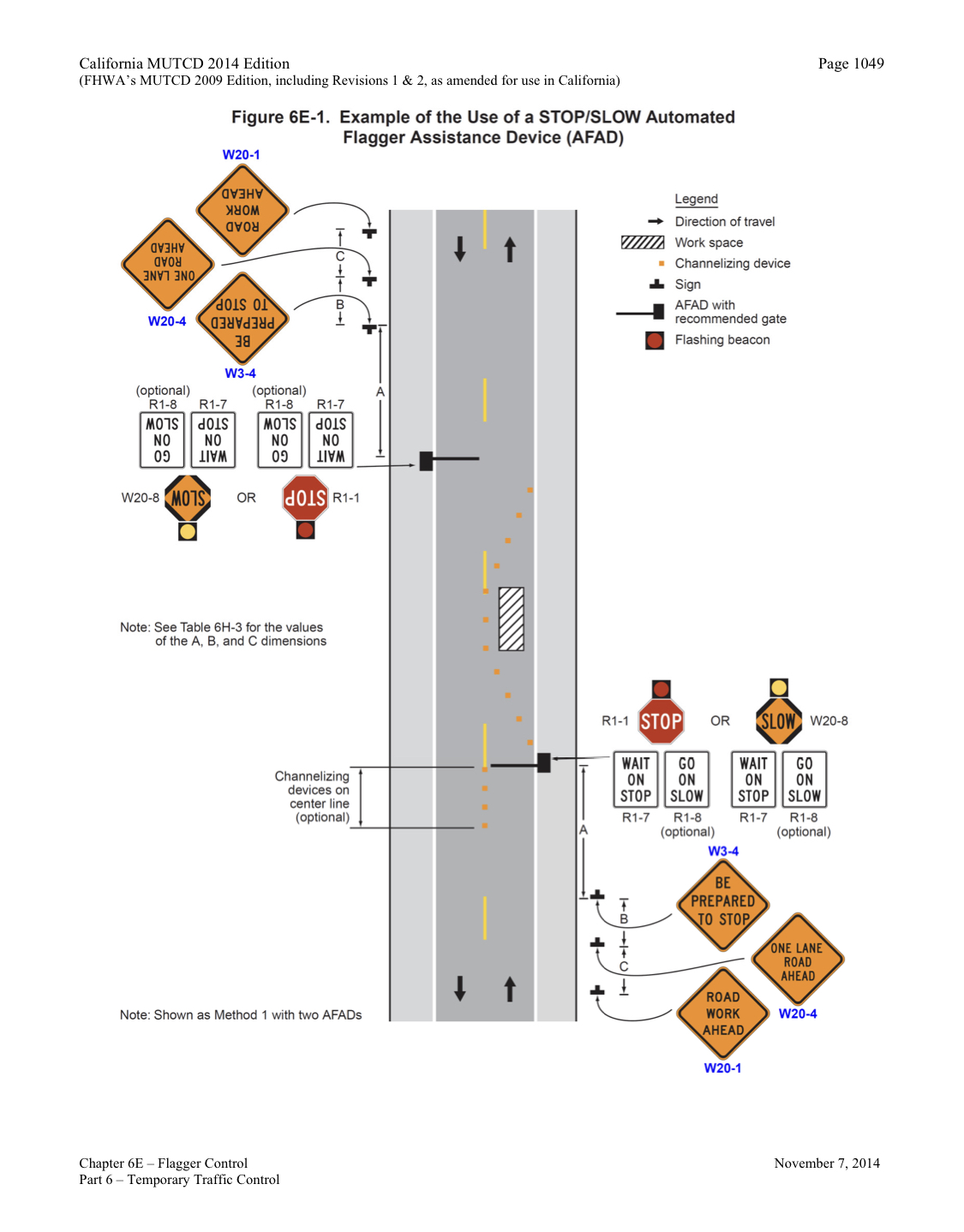With the revision of Caltrans standard drawing T13 on October 18, 2019, Caltrans is promoting the use automated flagger assistance devices for one-way reversible lanes. These AFADs allow the flaggers operating them to remain safely off the roadway.
Here is the text from the CA MUTCD (refer to the manual for original formatting).
Section 6E.04 Automated Flagger Assistance Devices
Support:
01 Automated Flagger Assistance Devices (AFADs) enable a flagger(s) to be positioned out of the lane of traffic and are used to control road users through temporary traffic control zones. These devices are designed to be remotely operated either by a single flagger at one end of the TTC zone or at a central location, or by separate flaggers near each device’s location.
02 There are two types of AFADs:
A. An AFAD (see Section 6E.05) that uses a remotely controlled STOP/SLOW sign on either a trailer or a movable cart system to alternately control right-of-way.
B. An AFAD (see Section 6E.06) that uses remotely controlled red and yellow lenses and a gate arm to alternately control right-of-way.
03 AFADs might be appropriate for short-term and intermediate-term activities (see Section 6G.02). Typical applications include TTC activities such as, but not limited to:
A. Bridge maintenance;
B. Haul road crossings; and
C. Pavement patching.
Standard:
04 AFADs shall only be used in situations where there is only one lane of approaching traffic in the direction to be controlled.
05 When used at night, the AFAD location shall be illuminated in accordance with Section 6E.08. Guidance:
06 AFADs should not be used for long-term stationary work (see Section 6G.02).
Standard:
07 Because AFADs are not traffic control signals, they shall not be used as a substitute for or a replacement for a continuously operating temporary traffic control signal as described in Section 6F.84.
08 AFADs shall meet the crashworthy performance criteria contained in Section 6F.01. Guidance:
09 If used, AFADs should be located in advance of one-lane, two-way tapers and downstream from the point where approaching traffic is to stop in response to the device.
Standard:
10 If used, AFADs shall be placed so that all of the signs and other items controlling traffic movement are readily visible to the driver of the initial approaching vehicle with advance warning signs alerting other approaching traffic to be prepared to stop.
11 If used, an AFAD shall be operated only by a flagger (see Section 6E.01) who has been trained on the operation of the AFAD. The flagger(s) operating the AFAD(s) shall not leave the AFAD(s) unattended at any time while the AFAD(s) is being used.
12 The use of AFADs shall conform to one of the following methods:
A. An AFAD at each end of the TTC zone (Method 1), or
B. An AFAD at one end of the TTC zone and a flagger at the opposite end (Method 2).
13 Except as provided in Paragraph 14, two flaggers shall be used when using either Method 1 or Method 2.
Option:
14 A single flagger may simultaneously operate two AFADs (Method 1) or may operate a single AFAD on one end of the TTC zone while being the flagger at the opposite end of the TTC zone (Method 2) if both of the following conditions are present:
A. The flagger has an unobstructed view of the AFAD(s), and
B. The flagger has an unobstructed view of approaching traffic in both directions.
Guidance:
15 When an AFAD is used, the advance warning signing should include a ROAD WORK AHEAD (W20-1) sign, a ONE LANE ROAD (W20-4) sign, and a BE PREPARED TO STOP (W3-4) sign.
Standard:
16 When the AFAD is not in use, the signs associated with the AFAD, both at the AFAD location and in advance, shall be removed or covered.
Guidance:
17 A State or local agency that elects to use AFADs should adopt a policy, based on engineering judgment, governing AFAD applications. The policy should also consider more detailed and/or more restrictive requirements for AFAD use, such as the following:
A. Conditions applicable for the use of Method 1 and Method 2 AFAD operation,
B. Volume criteria,
C. Maximum distance between AFADs,
D. Conflicting lenses/indications monitoring requirements,
E. Fail safe procedures,
F. Additional signing and pavement markings,
G. Application consistency,
H. Larger signs or lenses to increase visibility, and
I. Use of backplates.

